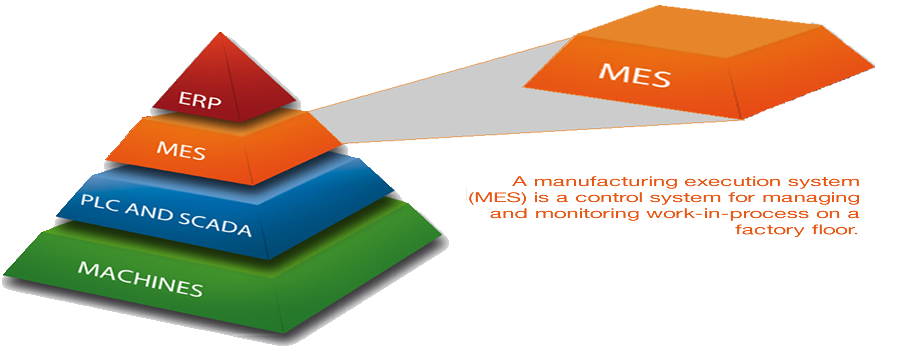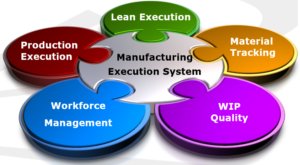MES
Manufacturing Execution Systems

MES isn’t a specific technology, but more of a general description for many components. A good way to look at MES is as a bridge between ERP and the production environment. ERP takes the order and plans production while PLC, HMI, SCADA and of course people do the actual production work. MES keeps those systems in step – providing instructions to the production environment and reporting progress back up to management and sales (and in some cases even customers).
MES can be implemented in many ways and can include many different technologies. In a fully integrated system, the MES will automatically process new orders as they are scheduled by your ERP (or APS) and will process data from HMI/SCADA systems back into ERP and Business Information systems. Often, custom dashboards will display WIP and planned jobs on large displays throughout the shop floor. These displays keep production workers informed and help plant managers take quick status checks without having to return to their offices.
Continuous Improvement
Continuous improvement is an important concept in the context of manufacturing execution systems (MES). MES systems are designed to provide real-time data about the production process, allowing for the optimization of production processes. With continuous improvement, MES systems can be used to identify areas of the production process that can be improved, and to make adjustments to the process in order to increase efficiency and reduce costs. Continuous improvement also allows for the identification of areas where additional resources may be needed, and for the implementation of new technologies and processes that can further improve the production process.
 Continuous improvement can also be used to identify and reduce production bottlenecks, and to ensure that production is meeting customer requirements. By using MES systems to track production data, manufacturers can identify areas where production is not meeting customer expectations, and can make adjustments to the production process to improve the quality of the product. Additionally, continuous improvement can be used to identify areas where production can be automated, reducing the need for manual labor and increasing efficiency. By using MES systems to identify areas for improvement, manufacturers can ensure that their production processes are running as efficiently and cost-effectively as possible.
Continuous improvement can also be used to identify and reduce production bottlenecks, and to ensure that production is meeting customer requirements. By using MES systems to track production data, manufacturers can identify areas where production is not meeting customer expectations, and can make adjustments to the production process to improve the quality of the product. Additionally, continuous improvement can be used to identify areas where production can be automated, reducing the need for manual labor and increasing efficiency. By using MES systems to identify areas for improvement, manufacturers can ensure that their production processes are running as efficiently and cost-effectively as possible.
ERP vs MES
ERP systems are “data-driven”, in other words an ERP system responds to the data being input. By contrast, MES is event-drive, or data is created in response to events. User intervention in an MES is typically limited to the recording or approving of an event – labor entry on a job or assigning a reason for machine downtime. This keeps MES interfaces very simple and often only requires handheld computers or tables for all user functions.
An MES will receive orders from ERP and deliver them to shop floor interfaces (PCs, PLCs, HMI, DNC). As work is performed the events triggered by labor entry, bar code/RFID movements and/or HMI/SCADA systems are captured by the MES to be recorded and reported back to the ERP, Executive Dashboards or even customer portals. MES provides a clear view of what is happening, where it is happening and with proper configuration even why it is happening.
Integration
The hairiest part of adding new technology to a manufacturing process is the integration. We specialize in making our technology fit between your ERP and manufacturing equipment without leaving your employees in the dark.
It’s never easy to make a cutting-edge ERP system communicate with a two ton press built in the 90’s. Continu8 is comprised of experts in legacy and modern manufacturing, so we know what software providers can communicate with each other, and how to make them less compatible systems communicate seamlessly.
Common Components of Continu8’s MES
Continu8’s MES can be as simple or complex as your environment requires. Most start out with one component and grow as a manufacturer’s needs evolve. Some of the common components found in MES today are:
Shop Floor Status Boards
Status boards, or “station dashboards”, are a great way to keep important information in front of employees. This technology reduces human error and synchronizes your operation.
Executive Dashboards
Monitor your entire process at the individual machine level and receive live updates. Get direct access to nesting/material optimizations and downtime reports.
Barcodes, RFID, and other Quick Identifiers
Nothing makes accountability as quick and accurate as the humble barcode scanner. Checkpoints for progress are essential for keeping track of efficiency.

